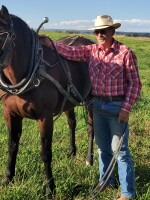A listener recently asked me why ground beef is so much more expensive than it was a year ago. Well, I replied, there is no simple answer, as some politicians would have us believe. An article by Michelle Rook in the Drovers Journal points out where we are at when it comes to beef production in the U.S. First, the law of supply and demand has come into play, with the U.S beef cattle herd shrinking to the lowest level in the last 50 years, due to prolonged drought conditions in the great plains and western states, that dried up pastures and rangelands. This forced many ranchers to sell off a part of their herds, which led to fewer calves, and in turn, there were fewer cattle going into feedlots, where profit margins are thin because of high feed costs. But these higher feed costs aren’t because crop farmers are getting rich. They are dealing with increased costs of machinery replacement, repairs and fuel, while also struggling to find employees who are willing to work long hours during the time of crop planting, cultivating and harvesting. But a bumper crop for U.S. grain farmers is beneficial for cattle feeders because their feed costs are lower, while farmers take a hit, because larger crop yields often don’t make up for the lower prices they receive.
Consumers may be looking at higher beef prices for a while, according to Darrell Peel, Extension livestock specialist at Oklahoma State University. “I think we could see elevated cattle prices for much of the rest of the decade. History tells us that we tend to put in a peak about a year to a year and a half after we know we’re saving heifers for rebuilding. And I’ll say this, people worry about a sharp drop like we saw about a decade ago, but this is a very different situation. A decade ago was the fastest rebuild in history. This time, we’re on the slowest rebuild in history. It’s a completely different model.” Recent comments from Washington suggest cattle and beef prices are “too high,” but Peel says the current price levels make sense when viewed in context. “There’s always a speculative element to these markets. That means there’s always an opportunity to push prices a little higher, and we can certainly see temporary corrections because of that. But fundamentally, I don’t think we are too high. This market has very strong underlying foundations for why we’re where we are right now.”
Another consideration concerning beef pricing is the cost of getting beef from the pasture to consumers plates that has also become more expensive due to higher energy costs that is also affecting feedlots and cattle slaughter facilities. Operating costs for this stage of beef production has climbed sharply over the past few years, with labor shortages in meatpacking and processing plants pushing wages higher, while with fewer workers available, plants end up operating below capacity, causing slower output that raises the cost of beef for meat wholesalers and retailers that is passed on to consumers.
The fallout concerning Trump’s announcement about importing Argentine beef in order to lower the cost of beef for U.S consumers last month is still rankling cattlemen. According to the U.S. Cattlemen's Association President Justin Tupper, “Trump’s announcement “was a slap in the face for U.S. cattle producers, and it is also questionable whether the move would do anything to lower the cost of beef for U.S. consumers.”
Theodore Roosevelt wrote, “When they call the roll in the Senate, the Senators do not know whether to answer 'Present' or 'Not Guilty'.”






